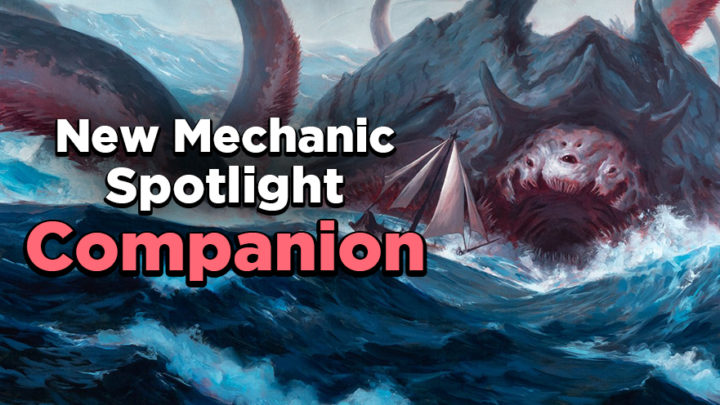Editor’s note: On June 1, 2020, Wizards of the Coast announced a change to the companion mechanic. Companions may no longer be cast from the sideboard; instead, players must pay 3 mana of any color to put a companion from their sideboard into their hand. The Commander Rules Committee has clarified that “[c]ompanion will operate in Commander similarly to other formats (meaning you’ll have to pay the 3, etc.), save that it will not come from your sideboard.”
One of the exciting new mechanics in Ikoria: Lair of Behemoths is companion, which places constraints on your deck-building in return for letting you cast some amazing rewards from your sideboard. There are ten cards with companion in Ikoria, each in a different color pair, and nine of them look like they’re going to do interesting things in Brawl and Commander.
Lutri, the Spellchaser
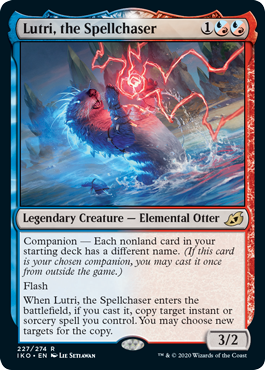
Let’s start with a look at the companions you can’t use in Brawl or Commander. Lutri, the red/blue companion, has been banned in both formats because its deck-building restriction essentially makes it a freebie for URx decks. There would be no reason not to use Lutri, so those decks would always have a copy spell on hand to cast whenever they felt like it.
Yorion, Sky Nomad
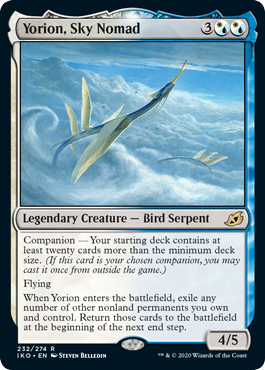
Yorion, the white/blue companion, is legal in Brawl and Commander decks and can be your commander. However, it can’t be used as a companion because its deck-building restriction changes the size of your starting deck. Unlike other formats, which only specify the minimum size for a deck, Brawl requires decks to have exactly 60 cards and Commander requires decks to have exactly 100 cards. Effects that change the number of cards in your deck are not allowed.
Lutri and Yorion are still legal in other formats, though, so let us know what you’re doing with it in formats that allow them.
With that out of the way, here are some suggestions for things you can do with the other Companions in Brawl and Commander.
Umori, the Collector
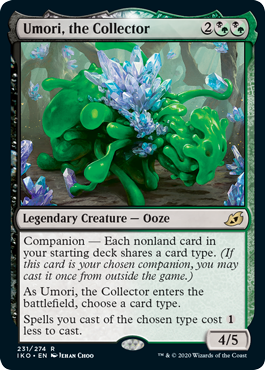
Umori, the green/black companion, restricts the spells in your starting deck to cards of a single type; as a reward, Umori makes those cards cheaper to cast. It’s easiest to build an Umori deck with creatures, since there are a lot of creatures that replicate the effects of powerful noncreature spells. Where Umori gets interesting is when you try to build a deck with other card types.
In Brawl, you can play Umori with artifacts. You’re restricted to using Golos, Tireless Pilgrim (the only legendary artifact creature in Standard) as your commander, but there are enough artifacts in Standard that it will work.
You can also play Umori with artifacts in Commander, but the card pool is also big enough that you can choose enchantments or Planeswalkers as well. However, you’d have fewer options for selecting a commander in either of these instances, since your companion has to share your commander’s color identity. Pharika, God of Affliction is the only legendary black/green enchantment creature, and Lord Windgrace is the only Planeswalker in Umori’s colors that can be a commander. But if you’re up for a fun deck-building challenge, these are two great options.
Kaheera, the Orphanguard
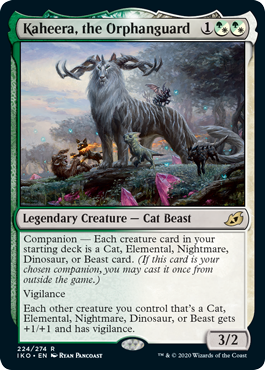
Kaheera, the green/white companion, restricts your starting deck to using only the five creature types that make up the monster “clades” of Ikoria: cats, elementals, nightmares, dinosaurs, and beasts. It gives creatures of these types +1/+1 and vigilance, and this tribal effect makes it an auto-include in the sideboards of decks that prioritize those creature types.
In Brawl, the only creature commander that meets Kaheera‘s deckbuilding restriction is Nethroi, Apex of Death. But there are plenty of creatures from all five clades in Standard, including creatures with mutate that can interact with Nethroi‘s mutate ability. You may also want to try Kaheera in an Ajani, the Greathearted deck, especially if you include Ajani, Strength of the Pride for extra cat value.
In Commander, you can play Kaheera with a few different tribal commanders, including Gishath, Sun’s Avatar, Horde of Notions, and Arahbo, Roar of the World. If you do make a dinosaur deck with Kaheera, though, be aware that you can’t use human creatures like Otepec Huntmaster and Knight of the Stampede that make dinosaurs cheaper to cast. You may want to replace these humans with other ramp spells to make sure you can keep casting your dinosaurs on curve.
Obosh, the Preypiercer
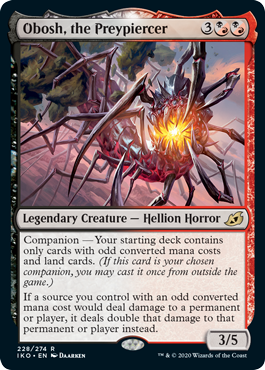
Obosh, the red/black companion, restricts the nonland cards in your starting deck to having odd converted mana costs, but it boosts the damage dealt by spells with odd CMCs. The decks that benefit most from Obosh are those that prioritize dealing a lot of damage quickly. In Brawl, you may want to try it in a Judith, the Scourge Diva deck packed with creatures with damage-dealing abilities. In Commander, it pairs well with Nekusar, the Mindrazer, Kaervek the Merciless, or Vial Smasher the Fierce.
Gyruda, Doom of Depths
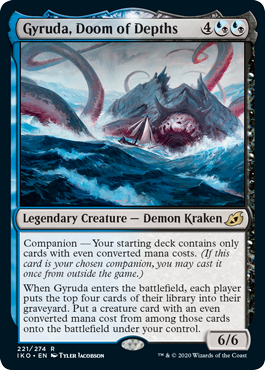
Gyruda, the blue/black Companion, restricts the cards in your starting deck to having even converted mana costs. It also mills each player for four cards when it enters the battlefield, so it will play best alongside a deck that can turn self-mill into an advantage. In Brawl, it will play well with Ashiok, Sculptor of Fears or Lazav, the Multifarious; you may also want to include Thassa’s Oracle or Jace, Wielder of Mysteries as alternate win conditions. If you’re feeling up to it, you might even stack your deck with Persistent Petitioners.
Similarly, in Commander, Gyruda will play well with any UBx deck running Laboratory Maniac. It will also work well with commanders that let you return cards from your graveyard, like Muldrotha, the Gravetide, or commanders that let you profit from putting things into your graveyard, like Sidisi, Brood Tyrant.
Keruga, the Macrosage
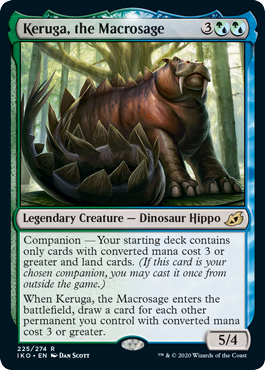
Keruga, the green/blue companion, restricts the nonland cards in your starting deck to having converted mana costs of 3 or greater. When it enters the battlefield, it lets you draw cards equal to the number of permanents of CMC 3 or greater you control, which suggests a deck design that prioritizes permanents. Keep in mind that, since your curve starts at three mana, your deck is going to start slowly, so you should be ready to recover if your opponents start ganging up on you.
In Brawl, Keruga plays well with Illuna, Apex of Wishes. It might also be interesting in a Eutropia, the Twice-Favored or Prime Speaker Vannifar deck. In Commander, you may want to try it with commanders like Animar, Soul of Elements that care about specific permanent types, or ramp commanders like Kruphix, God of Horizons.
Lurrus of the Dream-Den
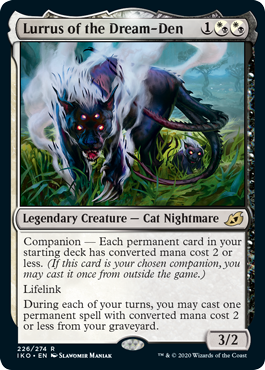
Lurrus, the white/black companion, restricts the cards in your starting deck to having converted mana costs of 2 or less, but it lets you cast permanents with CMC 2 or less from your graveyard. Unfortunately, there aren’t any commanders in Brawl that meet Lurrus‘s deck-building restriction, so you can’t choose it as your companion in Brawl. In Commander, you have two options: Ayli, Eternal Pilgrim and Karlov of the Ghost Council. Either way, I recommend putting as many permanents in the deck as possible to take maximum advantage of Lurrus‘s ability.
Jegantha, the Wellspring
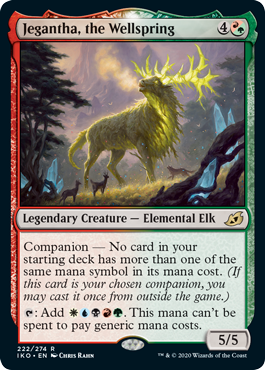
Jegantha, the red/green companion, restricts the spells in your starting deck to those that don’t have two or more of the same colored mana in their casting costs, and it can be tapped for WUBRG to pay colored costs. Its activated ability means it can only be played in 5-color Commander or Brawl decks, but it will also be valuable fixing in those decks.
Niv-Mizzet Reborn is a great deck for Jegantha. If you were on the fence about trying him out, now is the time; just be aware that you can’t use any of the MMNN spells from Guilds of Ravnica or Ravnica Allegiance (such as Crackling Drake or Frilled Mystic). In Commander, Jegantha can support five-color tribal commanders like Najeela, the Blade-Blossom and Horde of Notions, as well as commanders that change costs to WUBRG like Jodah, Archmage Eternal.
Zirda, the Dawnwaker
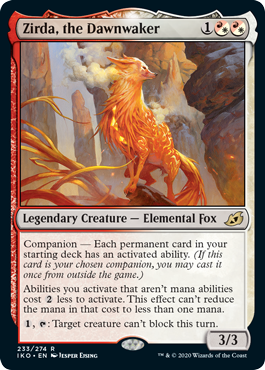
Zirda, the red/white companion, requires all permanents in your starting deck to have an activated ability, and makes non-mana abilities cheaper to activate. It also has an activated ability of its own that makes a creature unable to block. These abilities suggest that it will play well with aggressive decks. An easy way to find permanents with activated abilities is to search Scryfall for cards that contain a colon (:) in their oracle text. However, this won’t return cards with equip or cycling abilities, so you’ll have to search for them separately.
In Brawl, Zirda has a home in the sideboard of a version of Guilds of Ravnica‘s mentor deck, with Tajic, Legion’s Edge as the commander. You may also want to try it alongside a Nahiri, Storm of Stone deck, since equip abilities and Planeswalker loyalty abilities count as activated abilities. In Commander, Zirda fits in with aggressive commanders like Samut, Voice of Dissent and Razia, Boros Archangel.
I Choose You
Adding a companion to your Brawl or Commander deck is a great way to spice up your deck-building. Let us know what kind of decks companion inspires you to build!

Alex is an Azorius bureaucrat who dreams of joining the Selesnya Conclave. Their favorite color of mana is green, and they love brewing for Commander variants.

